Crew 219 Science Report 08-JAN-20 Crew Science Officer: Hannah Blackburn 1. Biometrics and Neurobehavioral Research Continued taking sleep and post-EVA logs. Post-EVA biometrics were recorded. 2. UAV Nothing to report. 3. Dust Mitigation for Optical Mirrors Optics mount and mirror were checked on EVAs 5 and 6 and photographed. 4. Astrophotography of Celestial Bodies Nothing to report. 5. Remediation of Mars Regolith Regolith was inoculated. 6. Chemical and Mineralogical Composition of the MDRS Site Samples were dried in the oven using glass beakers. Additional samples were taken during EVA 6. 7. Protocols for the Discovery of Life on Mars Nothing to report. Glassware check out: 10 glass beakers (sizes between 200 and 500 ml) were used to dry regolith samples in the oven, and we will need them for the same purpose tomorrow.
Greenhab Report – January 8th
Crew 219 GreenHab Report 08-JAN-20 Crew GreenHab Officer: Cynthia Montanez Environmental control: Heating. Shade cloth (40% and 30%) on. Average temperature: 18.8 °C; 20.7 % Average Max: 23.4 °C, 23% Average Min: 12.7 °C, 18.3% 9:20 A.M. Floor Unit: 8 °C Electronic: 16.4 °C humidity 22% Max: 21.4 °C; 24% Min: 12.7 °C; 19% 3:24 P.M. Floor Unit: 15 °C Electronic: 22.2 °C humidity 19% Max: 26.1 °C; 24% Min: 12.7 °C; 17% 5:34 P.M. Floor Unit: 10 °C Electronic: 17.9 °C humidity 21% Max: 22.6 °C; 21% Min: 12.7 °C; 19% Hours of supplemental light: Light system 7:00PM-12:00AM. Daily water usage for crops: 4.86 Gal. Daily water usage for research and/or other purposes: N/A Water in Blue Tank – ~200.27 Gal. Time(s) of watering for crops: 9:20 A.M. SEASONAL PLANTING HISTORY: Change to crops: All the crops in the direct path of the heater are staring to have crispy, dry leaves despite the daily watering. OTHER NOTES: 1st sprouts: N/A Harvest: At 4:40 P.M., 18 grams white onions of was harvested. Other: I was able to fix the temperature of the thermostat within the greenhouse. The temperature before was at 16 °C and I placed it to 21 °C. Additionally, I planted two pots of snow peas, and one pot of white onions. The snow peas are placed on plot A, column E, row 7; as the white onions are on plot B, column F2, third shelf. The photos requested by Director Rupert are attached below. Suggestions: Since the thermostat was changed to 21 °C, the floor temperature has increased to desired ranges (between 10 °C - 15 °C). However, because of the angle the vents are for the heater, the heat is directly hitting the hanging plants. Prior to this, some of the hanging plants, e.g. cucumber, lettuce, and snow peas, had been burning a bit on the tips of the leaves. By increasing the heat, the hanging plants are now burning more and the soil is drying out faster. I was wondering if it was possible to rearrange some of the plants and place them in other areas of the greenhouse. For instance, since snow peas prefer cooler to warm temperatures, all the hanging snow peas can be connected and placed in the back of the GreenHab by the herb bed. Also, the lettuce can also be placed at the back of the GreenHab and connected with the other lettuce pots. The Narcissis plants can be placed on the top of the plant stand in plot B and the spinach tray can be underneath the plant bed next to the GreenHab doors. I can put all the watering cans on the bottom rack where the pots and plant food are to keep things organized, and the metal trellis can be placed in the back right corner of the GreenHab where the icicle radish’s are. Finally, I would move the bags of soil to the other side of the desk so that it will be placed by the rack.
EVA Report – January 8th
Crew 219 EVA Report 08-01-2020 EVA #5 Author: Dave Masaitis Purpose of EVA: Geologic sample collection and monitoring of dust mitigation experiment Start time: 0904 hrs End time: 0931 hrs Narrative: EVA #5 departed the Hab on foot at 0904 hours and moved over to the dust mitigation experiment. R. Raphael made his observations, and the EVA team then moved west to ascend Hab Ridge. By the time the team crested the first set of hills on the way to the ridge, D. Masaitis called a short halt to allow team members some time to allow visor fogging to subside. Within minutes, D. Masaitis was able to make the observation that his helmet’s air vents were misaligned and were only able to defog the very bottom corners of his visor. Given that he was not fully fogged, the team decided to try and continue climbing. Three-quarters of the way up the ridge line, D. Masaitis noted that snow cover and ground conditions would prohibit the whole team from making it up the ridge line with the necessary sampling equipment. He conferred with H. Blackburn, and they decided to abandon the climb in the interests of crew safety. D. Masaitis called N. Hadland at the hab to discuss options. Since a last minute change of sampling location would violate procedure, D. Masaitis made the call to terminate the EVA, and EVA #5 returned to the airlock at 0931 hours. Destination: SW of Hab Ridge Coordinates: 0517500/4250100 Participants: D. Masaitis (CO), A. Perez (ENG), H. Blackburn (LSO), R. Raphael (ASTRO) Roads and routes per MDRS Map: W to Hab Ridge, S on Hab Ridge Rd. to target location
Crew 219 EVA Report 08-01-2020
EVA #6
Author: Nathan Hadland
Purpose of EVA: Sample collection for mineralogy project and taking photographs of the optical mount for dust mitigation project
Start time: 1252 hrs
End time: 1449 hrs
Narrative: Under HSO advisement, a personnel change was made in the EVA crew. EVA #6 initiated a 5-minute decompression at 1252 hours and moved out on foot to the vicinity of the Robotic Observatory. After taking photographs of the optical mount setup to check for dust collection, we moved back to Curiosity and Spirit. After reporting SOC and hours, we progressed south along Cow Dung Road. We dismounted the rovers just past Robert’s Rock Garden and moved east on foot along the base of Kissing Camel Ridge E and then north towards Phobos Peak. After reaching an area directly south of the peak, Abdul (GEO) identified a flat site for sample collection. We collected 5 samples in a grid and recorded GPS locations. The EVA crew then headed southwest back to the rovers. Curiosity and Spirit proceeded safely back to the Hab at 1444 hours and the EVA crew successfully pressurized in the air lock at 1449 hours.
Destination: Phobos Peak
Coordinates: 0519500/4250100
Participants: Nathan Hadland (XO), Abdul Elnagdi (GEO), Keith Crisman (HSO), Robinson Raphael (ASTRO)
Roads and routes per MDRS Map: South along Cow Dung Road (0110), parked just south of Robert’s Rock Garden and then proceeded east on foot towards Kissing Camel Ridge E and then north towards Phobos Peak.
Mode of travel: Rovers (Spirit and Curiosity) and foot travel
Crew Photos – January 8th
Operations Report – January 8th
Operations Report Crew 219 Operations Report 08-JAN-2020 Sol: 3 Name of person filing report: Alejandro Perez Non-nominal systems: N/A Generator: Run Hours run: 14 From what time last night: 17:00 To what time this morning: 07:00 List of any additional daytime hours when the generator was run: N/A Solar- SOC% (Before the generator is run at night): 59% Diesel Reading - 73% Station Propane Reading- 51% Ethanol Free Gasoline- N/A Water (loft tank) (gal) – 50 Water Meter (units)- 0147473,1 Water (static tank) (gal) – 506 Static to loft Pump used – Yes Water in Green Hab (gal): 200.02 Water in Science Dome (gal): 0 Toilet Tank Emptied – Yes Diemos rover used: Still in the Work shop Hours: Beginning Charge: End Charge: Currently Charging: Sojourner rover used: Assigned to Director Hours: Beginning Charge: End Charge: Currently Charging: Spirit Rover used- Yes EVA #6 Starting Hours: 123.5 Beginning Charge: 100% Ending Hours: 123.7 Ending Charge: 68% Opportunity Rover used: Still in workshop Hours: Beginning Charge: Ending Charge: Currently Charging: Curiosity Rover used: Yes EVA #6 Starting Hours: 129.3 Beginning Charge: 100% Ending Hours: 129.5 Ending Charge: 70% Notes on Rovers: Opportunity and Deimos off-site for maintenance. ATV’s Used: (Honda, 300, 350.1, 350.2, 350.3): No Reason for use: Oil Added? No # hours the ATV’s were used today: Notes on ATVs: Habcar used and why, where? Used by Outpost team to take Crew car to the Work shop, refilled with gas. CrewCar used and why, where? Crew car was brought to the workshop, is off site, and was refilled. General Notes and Comments: Summary of the internet: Nominal Summary of Suit and Radios: A two- piece helmet had vents that were stuck aiming downward providing no defogging during EVA #5. The vents freely rotate within this helmet and cannot be secured. Transformer for Charging unit 4 is giving very high amperage and voltage exceeding the limits for the radio batteries. This transformer has been marked not to be used. Also, during EVA there was a window where EVA radios were giving a persistent static. The radios are being tested and troubleshot for any deficiencies in connectivity, battery performance, and individual radio issues. Summary of Hab: Pipe froze again today. The heating coil is still functioning and the pump is still operating properly. The freezing seems to be in between the exterior wall and the interior wall leading to the washroom. This was solved using a combined method of warm water through the feedline, a hair dryer heating the interior and exterior pipe through the wall. Summary of Science Dome operations: Nominal Summary of Ram operations: Nominal Summary of any observatory issues: Nominal Summary of Health and safety issues: Nominal Questions, concerns, and requests to Mission Support: Requesting for Teflon tape for the loft tank feedline and new insulation for the Static tank to Loft tank pipe.
Crew Photos – January 8th
Journalist Report – January 8th
Crew 219 08-Jan-2020 Journalist Report Nathan Hadland, Crew 219 Executive Officer Sol 3 Here Comes the Sun White Mars is breathtakingly beautiful and continues to astonish us with both its magnificent landscapes and interesting science. Today, the Sun finally came out from behind the clouds briefly and greeted us across the vast void of 93 million miles for the first time since we arrived. Alejandro (ENG) and I share the loft in the Hab, which we have dubbed “The Penthouse.” We woke up early to treat our crew with blueberry pancakes before the day’s activities. The rest of the morning was spent helping with EVA prep. Our EVA’s have been running extremely smoothly because of the implementation of the Standard Operating Procedures (SOPs) developed by my last MDRS crew, the International Emerging Space Leaders Crew 205. These are essentially checklists designed to ensure that the appropriate equipment is operational, everyone understands the route and purpose of the EVA, and everyone is healthy and ready to go. Consequently, we never forget equipment and generally the EVA accomplishes their tasks quicker and more effectively. The purpose of both EVAs today were to continue sampling for our mineralogy survey and collecting data for our biometrics project. We have been getting extremely interesting data and I am excited to analyze what we have obtained so far post-mission. I will be taking the samples we have been collecting to Florida Tech’s X-Ray Diffractometer (XRD) and will work with the crew geologist to generate a GIS map of the mineralogical and chemical composition of the MDRS site. The first EVA started out smoothly, but Dave’s (CO) helmet almost immediately started fogging because the vents were not pointed directly at the visor! Other personnel were having fogging issues too because of the extreme cold so Dave decided to cancel the EVA and return to the Hab after taking pictures of the optical mount we set up. Upon arrival back at the Hab, the crew was warmly greeted with hot chocolate. The rest of the morning was spent catching up on work in the lab or laying on the couch and reading. I was on the second EVA and wow, the landscape was astonishing. After driving the rovers south, we walked along Kissing Camel towards Phobos Peak. Along the way, the Sun came out and warmed our backs and started freeing up additional sites for sampling. We also saw some mysterious tracks… perhaps some Martian antelope? We got some interesting samples along the base of the peak and returned back to the Hab. The EVA team was greeted by cream of mushroom soup and fresh bread prepared by Hannah, our Lead Science Officer (LSO). I have to commend her on the food she has been making; every meal has been a treat! Tomorrow, we are looking forward to continuing to explore this grand and magnificent environment with two EVAs planned and further analysis of our samples. Maybe we will see the Sun again tomorrow…
Sol Summary – January 8th
Crew 219 Sol Summary Report 08-01-2020
Sol: 2
Summary Title: Pancakes, Fresh Bread, Sunshine, and Snow Flurries
Author’s name: Dave Masaitis
Mission Status: Nominal
Sol Activity Summary: Sol 3 began with N. Hadland and A. Perez preparing a delicious pancake breakfast for the crew, followed by the departure and early return of EVA #5. Afterwards, the crew settled into science and maintenance tasks, punctuated by periods of novel reading. By 1230 hours, all hands went below to help EVA#6 prepare for departure. While they were out H. Blackburn baked a couple loaves of fresh bread, which would be summarily consumed after the EVA’s return. The crew spent their time before Comms troubleshooting radios and thawing water pipes (again). In great news, Crew 219 now has well established troubleshooting procedures to keep water flowing from the static tank to the loft tank.
Look Ahead Plan: We look forward to two more sampling EVA’s and will continue maintenance and science work around the campus.
Anomalies in work: None
Weather: Cold and overcast all day, with temperatures below freezing. There was a brief moment of sunshine towards sundown, which was quickly replaced with cloud cover and light snow flurries.
Crew Physical Status: Nominal
EVA:
EVA #5 – Geologic Sample Collection SW of Hab Ridge (0517500/4250100)
EVA #6 – Geologic Sample Collection around Phobos Peak (0519500/4250100)
Reports to be filed:
Sol Summary
EVA Reports 5 & 6
EVA Requests 7 & 8
Operations Report
GreenHab Report
Research Report
Journalist’s Report
Photos (Including Photo of the Day)
Support Requested:
Outpost is tracking current Support Request
Crew 218 Final Mission Summary
Mars Desert Research Station
Mission Summary
Crew 218 – The Next Giant Leap
Dec 21st, 2019 – Jan 4th, 2020
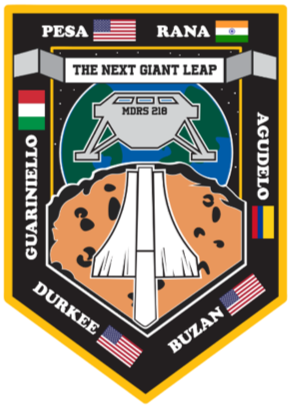
Crew Members:
Commander and Crew Astronomer: Dr. Cesare Guariniello
Crew Geologist: Pat Pesa
Crew Scientist and GreenHab Officer: Dr. Jonathan Buzan
Health and Safety Officer and GreenHab Officer: Shefali Rana
Crew Engineer: Luz Maria “Luz Ma” Agudelo Urrego
Crew Journalist: Benjamin “Ben” Durkee
Acknowledgements:
The entire Crew of MDRS 218 would like to express their gratitude to the many people who made this mission possible: our deepest thanks to Dr. Robert Zubrin, President of the Mars Society; Dr. Shannon Rupert, MDRS Director and Program Manager, who kept an eye on us and was our hero from 1500 miles away; Atila Meszaros and David Mateus, Assistant Directors, who managed and supported our mission in-situ, and helped us troubleshooting the little problems we encountered; Dr. Peter Detterline, Director of Observatories, who trained and assisted our Crew Astronomer before and during the mission; David Murray, GreenHab Team Lead; Michael Stoltz, The Mars Society Liaison, Media and Public Relations; Scott Davis, responsible for Spacesuits; the Mission Support CapCom who served during our rotation: Abhishek Soni, Bernard Dubb, Andrew Foster, Jeremy Sieker, Michelle Espinoza, Simran Mardhani; Purdue MARS, which initiated the crew selection for this mission; Denys Bulikhov, who was selected as commander and, even when he had to drop because of external reasons, gave me valid and very appreciated support; all the departments and people at Purdue University who supported this mission; and all the unnamed people who work behind the scene to make this effort possible, and who gave us a chance to be an active part of the effort towards human exploration of Mars.
Mission description and outcome:
MDRS 218 “The Next Giant Leap” is the third all-Purdue crew at MDRS. This mission encountered different challenges than my previous two experiences, with snow and cold keeping the crew indoors for the first 5 sols and making EVAs much more difficult. The logistics of mission preparation were also different, with two crewmembers being unable to participate to preliminary meetings in person. However, the crew reacted very positively to the adversities, creating strong bonds and always giving each other support in every aspect of the mission. Despite the difficulties, all crewmembers performed to very high standards and provided good work on their research projects, as well as support to projects of the other crewmembers. The morale was always high and is visible throughout our mission pictures, up to the very last day. Even challenges like frozen pipes who forced us to use an alternative pump and carry water upstairs in a chain of pots and containers was experienced like a bonding activity. The research described below touched many aspects of human exploration of Mars, including analysis of outdoor features such as underground structure, weather, and radio emissions, and studies of human factors and the importance of environmental and operational comfort. The crew was also involved in astronomy and outreach through social media, and one of their sol was filmed to be featured in inspirational videos.
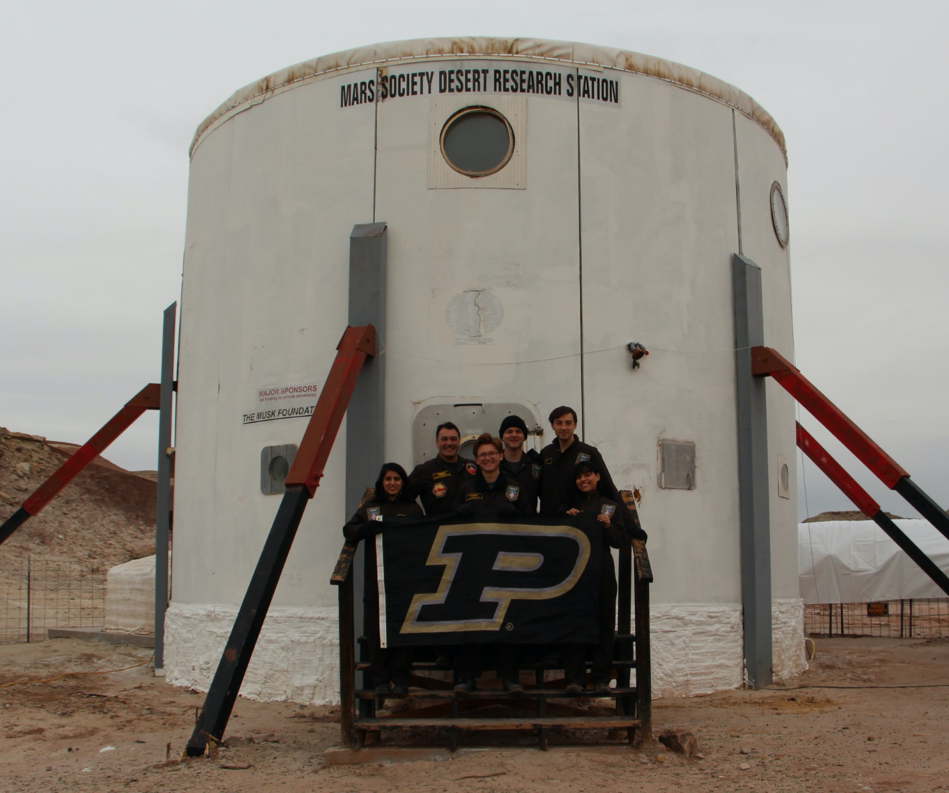
As commander, I am extremely proud of this crew, which faced adversities with flexibility and patience, and was capable to keep the highest level of fidelity and realism. The crew properly followed safety and research protocols, performed as a tight group, and found an appropriate mix of research activities and personal time, especially when the weather conditions forced us to review some of our goals. The pace kept throughout the mission was also challenging, ranging from slow days in the beginning, where our research activities were limited by the lack of EVAs which were necessary for many of our projects, to days with double EVAs, where the crew performed at very high level of quality and effort. As described in the rest of this summary, the crew collected useful and interesting data during their time at MDRS and has plans for use of the data after the completion of the mission, as well as ideas for laying foundations for further collaboration of Purdue crews with the MDRS program.
Summary of Extra Vehicular Activities (EVA)
After being trained in the use of rovers and in the safety protocols for EVA, the crew had twelve excursions during rotation 218, two of which being traditional short EVA to Marble Ritual, and the others being mainly along Cow Dung Rd because of the situation of the roads when covered in snow. Therefore, the EVAs were in areas in the Morrison Formation and Dakota Sandstone. The EVA served seven research projects: seismometric analysis of subsurface, radio measurements, collection of geological samples, autonomy for crew EVA, analysis of biometrics, meteorological observation and evaluation of EMU suits. The crew optimized the time on the field, limiting the driving time to less than 15-30% of the entire EVA duration.
| 1 | 2 | 3 | 4 | 5 | 6 | 7 | 8 | 9 | 10 | 11 | 12 | Total | |
| Sol | 2 | 2 | 4 | 5 | 6 | 7 | 8 | 9 | 10 | 11 | 12 | 13 | |
| Duration (h:mm) | 0:56 | 0:49 | 1:16 | 1:12 | 2:44 | 2:04 | 2:01 | 2:02 | 0:36 | 1:18 | 1:49 | 2:07 | 18:54 |
| Distance (miles) | 1.0 | 1.0 | 1.0 | 2.8 | 7.4 | 4.0 | 4.2 | 5.9 | 0.2 | 1.0 | 5.3 | 6.0 | 39.8 |
| % not driving | 89% | 88% | 100% | 69% | 74% | 87% | 83% | 86% | 100% | 75% | 81% | 72% |
Table 1. Summary of EVA, indicating Sol of execution, duration, distance covered, and time percentage spent in the field
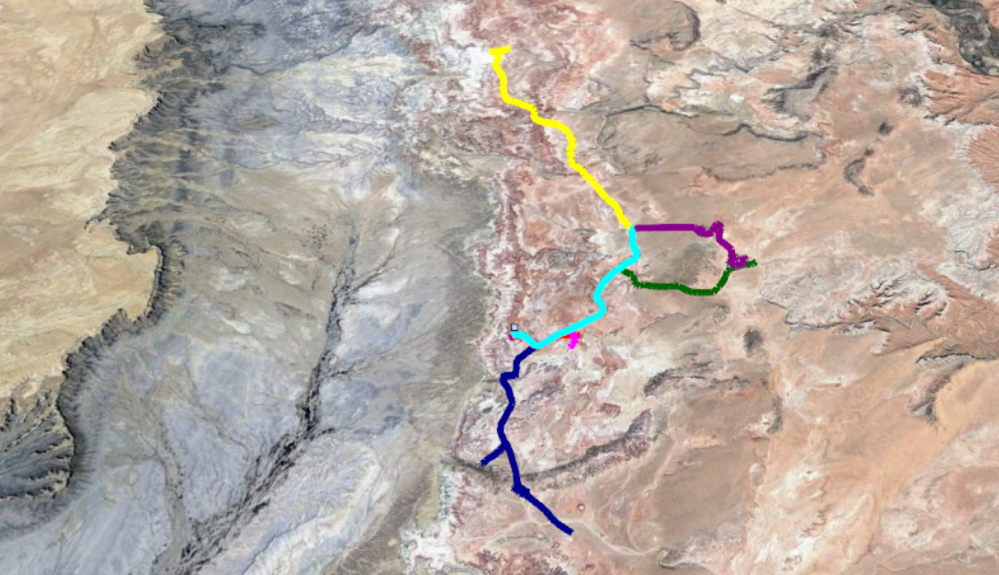
Summary of GreenHab Activities
Crew GreenHab Officer: Dr. Jonathan R. Buzan
The state of the GreenHab is in excellent condition. Snow peas have struggled during rotation, and the strawberries were eaten by a Martian Field Rodent (caught and released). However, the tomato plants, and cucumber have grown considerably, and the cucumber has flowered. We had nearly daily harvests, regular rosemary bread (until we ran out of flour), spices for sauces and curries, and a large salad for 8 people on December 25th. The GreenHab was multi-functional, providing not only food, but a sense of calm and peace in a small habitat building surrounded by a sea of red and snow-white landscape. Overall, the GreenHab was a great place to learn about taking care of multiple plants and is an excellent opportunity to harvest fresh vegetables.
Science Summary
We had 12 separate projects that covered a range of topics. The vast majority were EVA related and were not started until after the first week due to weather related EVA cancellations. The major indoor project evaluated the temperature in a single stateroom for stressful conditions. The EVA projects measured spatial satellite radio strength, rock sampling of surface and seismic mapping of subsurface stratigraphy, real-time measurements of human bio-physiology, EVA suit stressors, field maintenance, decision making, and weather observations. Overall, each project uniquely highlighted each crewmember’s strengths, and brought light to necessity of bringing humans to the surface of Mars for both scientific and engineering related research.
Research Projects:
Title: Decision Making in support of autonomy for crew EVAs
Author(s): Cesare Guariniello
Description, activities, and results: Continuing a research project started last year, during EVAs events have been suggested to the crew, which had to decide how to act following disruptions or injuries, loss of communication, or environmental difficulties. The crew had to decide whether to continue the EVA, modify the primary objective, proceed to secondary objective, or abort the excursion based on safety of the crew, current status of the mission, achieved partial goals, and potential further acquisition of data. Due to the weather conditions, most EVAs had similar destinations, length, and objectives, therefore only a couple of scenarios have been analyzed. While most situations have an obvious “right answer”, such as major injuries, some of the grey areas are more difficult. Even a small disruption when three astronauts are in EVA with two rovers might require two of them to separate from the third one, which can cause safety issues.
Title: Mars surface weather
Author(s): Jonathan Buzan
Description, activities, and results: Martian weather observation and prediction are crucial components for evaluating evolving EVA conditions and overall mission safety for a human crew on the surface of the planet. This project took regular measurements during EVAs. 1) Dr. Jonathan Buzan trained crew members in three critical observations for Martian weather prediction: 1) Observe visibility in the four cardinal directions, determining viewing distance; 2) Vertical observations of cloud cover, type, cloud deck height, and visibility; 3) In-situ temperature, humidity, luminosity, and wind measurements were taken. All of these observations become the baseline for the development of weather station instrumentation, and eventually, localized weather predictions. Most notable aspect of field operations was that the weather changed regularly and quickly, which highlights the importance of trained EVA observations and prediction of weather on Mars.
Title: Subsurface structure on Mars
Author(s): Pat Pesa
Description, activities, and results: The goal of the project was to demonstrate the use of instrumentation for structural analysis of potential locations for building on Mars. Several sites in the MDRS area were chosen based on having different stratigraphic layers and were analyzed using seismometric measurements to determine shallow subsurface rock structure. In-situ procedure was setting out a line of geophones to record data after small impacts gathering information on how vibration waves travel through the sub-surface. After the mission concludes the data will be further analyzed at Purdue with professor Dr. Doug Schmidtt. Applications of this data will be better understanding of non-invasive structural testing of Martian surface for building and development for a sustained human presence.
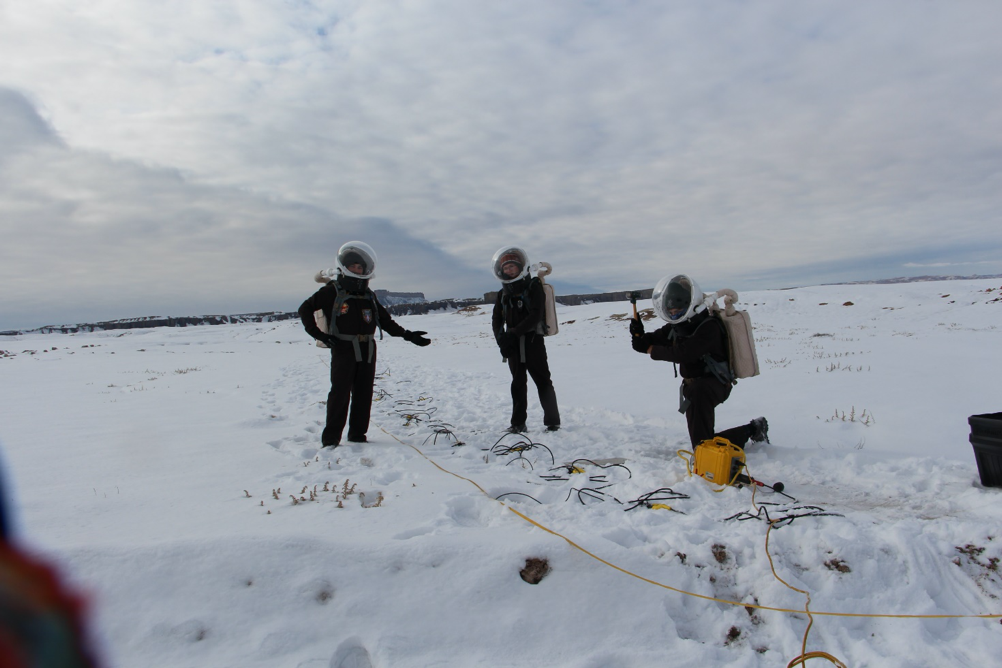
Title: Detecting radio signal strength
Author(s): Ben Durkee
Description, activities, and results: Radiological data was collected on the band of 436 MHz to 438 MHz. Surveys were done in various areas, including directly around the Hab, Cow Dung Rd, Galileo Rd, Kissing Camel Ridge, near White Moon, and more. Preliminary data processing has occurred, and more work is necessary to create the final heatmap of radio signal strength around MDRS
Title: EVA workload analysis
Author(s): Shefali Rana
Description, activities, and results: Feedback was collected from crew for long and short duration EVAs. Variation in score was observed for the exploratory EVAs conducted over a shorter distance versus ones for longer duration where heavier equipment was used for conducting the experiment. Different indicators will be analyzed to identify areas of larger discomfort.
Title: EMU (Extravehicular Mobility Unit) ergonomic assessment
Author(s): Shefali Rana
Description, activities, and results: EMU comfort parameters were scored by the crew for the two suits. There was a difference in score of comfort and ease of egress/ ingress between the two suits (light exploration suit and heavy two-piece suits). Scores also varied among the crew for what concerns ergonomics and ease of use.
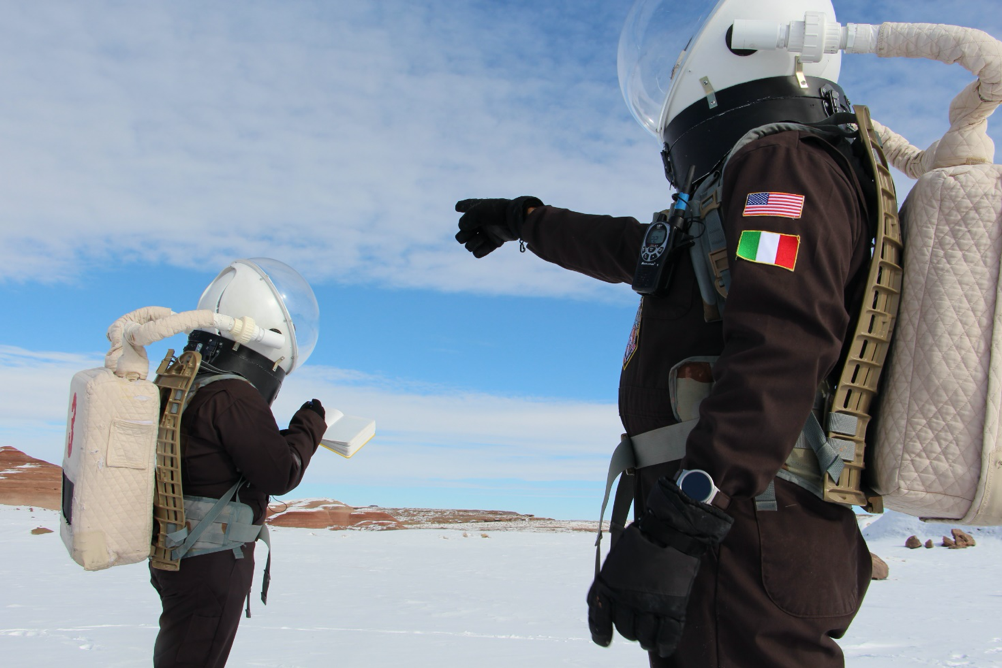
Title: Environmental Stresses over MDRS habitat and Crew Members and projection over Martian Terrain Author(s): LuzMa Agudelo
Description, activities, and results: Intending to understand the environmental conditions over Mars Terrain and design habitat structures and instruments that increase the human physical and mental capability, weather observations were performed, and data was collected over the MDRS terrain during Extra-Vehicular Activity (project no. 2). Data was also collected inside the habitat regarding temperature, humidity, wind, and radiation. Preliminary results on the crew engineer bedroom showed the nighttime temperatures with the door close surpassing the threshold of 26.6°C, considered the lower limit for human thermal heat stress, and a nighttime temperature average of 17°C with the door open.
Title: Messier and other space objects for outreach
Author(s): Cesare Guariniello
Description, activities, and results: The rotation saw only two days of clear skies. I managed to perform one day of Solar observations at the Elon Musk observatory, where the Sun did not show any spot or prominence, and one night where M42 (Orion Nebula) and M31 (Andromeda Galaxy) were observed and imaged in the robotic observatory. More observations have been submitted and will be processed after the end of the mission.
Title: Reliability and maintenance
Author(s): Shefali Rana
Description, activities, and results: Reliability of both the habitat structure and the EVA equipment is essential for safety. All equipment has to be installed, maintained and repaired on Mars by the crew and they have to be self-sufficient. For example, the habitat had a failure of the water pump pumping up the water to the tank for daily use. Repair procedure was initiated by crew Engineer. In this project, we simulated failure modes / malfunction of radio and rover during EVAs. Response of affected crew member and adherence / success of repair procedure was studied. This will be used to suggest operational protocols for failure scenarios.
Title: Medical readings in preparation for future crew-wide project
Author(s): Cesare Guariniello
Description, activities, and results: Crew commander wore a Zephyr sensor to monitor heart rate, breathing rate, body temperature, and level of activity 24/7 for three days during the mission. Data will be downloaded and analyzed after the mission, to evaluate areas and times of intense effort, and level of comfort and rest at night. The research project, in collaboration with prof. Barrett Caldwell at Purdue, will be extended to full crews in the future.
Title: Collection of clay and shale samples
Author(s): Cesare Guariniello
Description, activities, and results: Six samples have been collected for study in laboratory at Purdue. The samples will be evaluated for water content and geotechnical properties. Snow coverage did not allow for further collection.
Title: Media and outreach
Author(s): Ben Durkee
Description, activities, and results: @PurdueMDRS on Facebook & Instagram have been updated with pictures and progress updates every other sol. The posts and pictures are unique from each other and from the journalist reports and photos to make sure the audience is not receiving repeat content from all media. Video of Christmas celebrations needs final editing touches before being uploaded once back in regions of more reliable wi-fi.
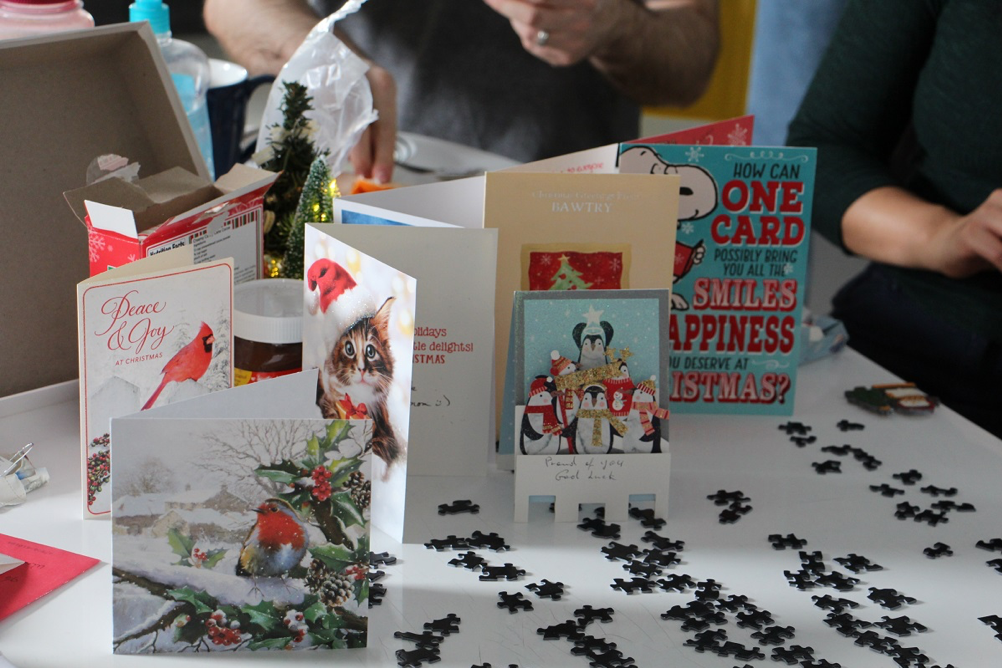
Mars Desert Research Station Crew 218 “The Next Giant Leap”


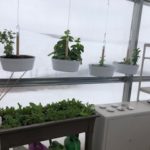
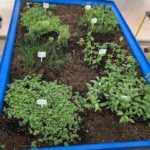
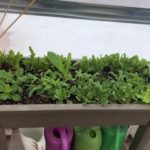

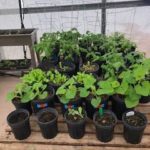

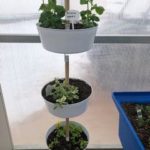
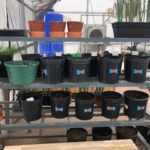
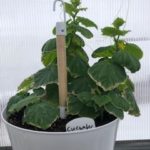
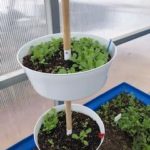
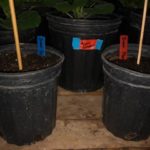
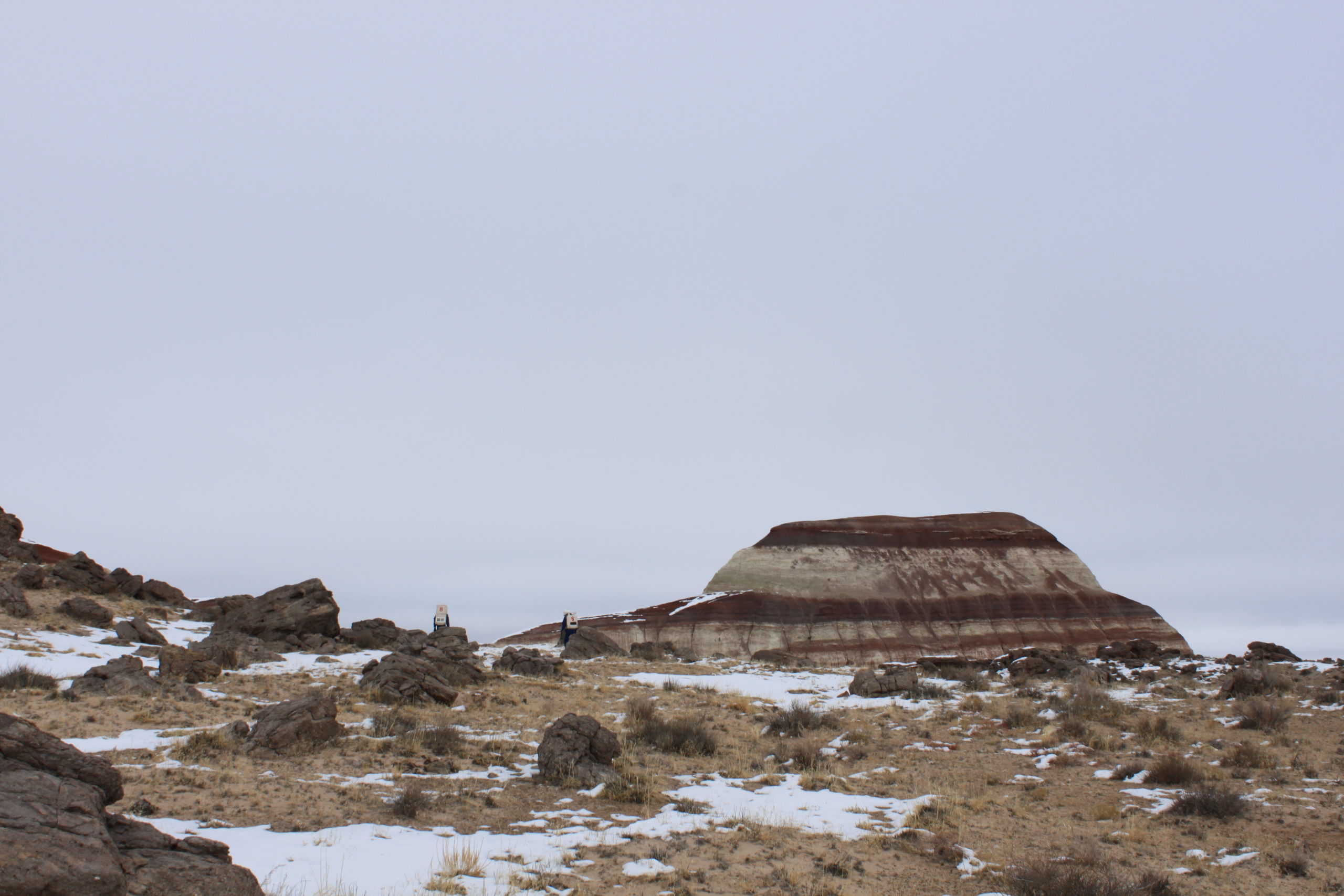
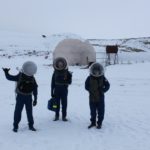
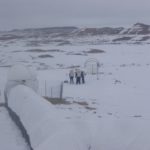

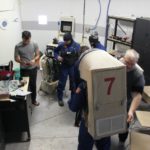
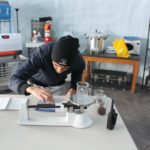

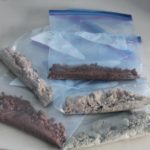
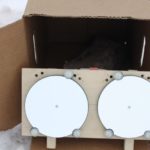
You must be logged in to post a comment.